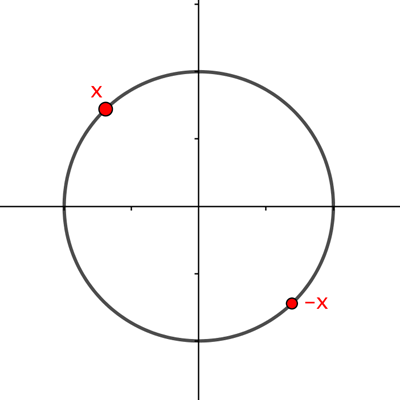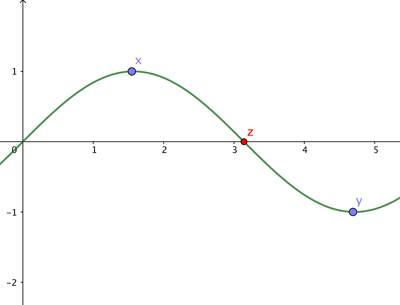Maths in a minute: Equal temperatures
At every given point in time there are two points on the equator of the Earth that have the same temperature.
How do we know this? Well, here’s a proof. Let’s look at the equatorial plane which slices through the Earth at the equator. The equator is a circle which lies in that plane, and we can choose a coordinate system on the plane so that the point  lies at the centre of the equator. For each point
lies at the centre of the equator. For each point  on the equatorial circle there is a point
on the equatorial circle there is a point  which lies diametrically opposite
which lies diametrically opposite  .
.

Points x and -x.
Now each point  on the equator comes with a temperature
on the equator comes with a temperature  . We can assume that the function
. We can assume that the function  , which allocates a temperature to each point, is continuous. That’s because temperature doesn’t suddenly jump up or down as you move around on the Earth.
, which allocates a temperature to each point, is continuous. That’s because temperature doesn’t suddenly jump up or down as you move around on the Earth.
Now consider the function
![\[ f(x) = t(x)-t(-x). \]](/MI/12d507399cd5f5ccc3c962e7847620b7/images/img-0004.png) |
It is also continuous.
If this function is equal to  for some point
for some point  , then we are done because if
, then we are done because if
![\[ f(x) = t(x)-t(-x)=0 \]](/MI/12d507399cd5f5ccc3c962e7847620b7/images/img-0006.png) |
then
![\[ t(x)= t(-x), \]](/MI/12d507399cd5f5ccc3c962e7847620b7/images/img-0007.png) |
so the temperature at  is the same as the temperature at
is the same as the temperature at  .
.
If  isn’t equal to
isn’t equal to  anywhere, then let’s assume (without loss of generality) that there is a point
anywhere, then let’s assume (without loss of generality) that there is a point  at which
at which  so
so
![\[ f(x) = t(x)-t(-x)>0. \]](/MI/12d507399cd5f5ccc3c962e7847620b7/images/img-0011.png) |
This implies that
![\[ f(-x) = t(-x)-t(x)=-f(x)<0. \]](/MI/12d507399cd5f5ccc3c962e7847620b7/images/img-0012.png) |
There is a result, called the intermediate value theorem, which says that if a continuous function is greater than  at some point of its domain and less than
at some point of its domain and less than  at another, then it must equal
at another, then it must equal  at some point in between the two.
at some point in between the two.

Illustration of the intermediate value theorem. If t(x)>0 and t(y)<0 and t is continuous, then there is a point z between x and y such that t(z)=0.
Thus, since  and
and  , there must be a point
, there must be a point  on the circle such that
on the circle such that  . So
. So
![\[ f(y) = t(y)-t(-y)=0 \]](/MI/d0a4e45b9878696932f1cb391fded146/images/img-0005.png) |
which means that
![\[ t(y)=t(-y). \]](/MI/d0a4e45b9878696932f1cb391fded146/images/img-0006.png) |
So the temperature at the point  is the same as the temperature at the point
is the same as the temperature at the point 
The result actually holds for any circle on the Earth, not just the equator. In fact, the result is the one-dimensional case of the Borsuk-Ulam theorem, which says that for any continuous function  from the circle to the real numbers there is a point
from the circle to the real numbers there is a point  such that
such that 
 from the
from the  -sphere to the set of
-sphere to the set of  -tuples of real numbers there is a point
-tuples of real numbers there is a point  such that
such that  .
.